
Chandni Rana
University of Florida
Sophomore, Biomedical Engineering
Expected Graduation: May 2019
Host Lab in Japan: Tabata Lab, University of Tokyo
Research Project Abstract and Poster: Enhancing the Detection Sensitivity of Terahertz Spectroscopy for Biomolecules using Metasurfaces ![]()
2016 Colloquium Winners | Smalley-Curl Institute
Chandni Rana wins Advantest Award in Undergraduate Poster Session.
Why Nakatani RIES?
In middle school, I was lucky to be amongst a very diverse crowd of students. I was surrounded by students whose heritages stemmed from all over the globe. Growing up in a setting like this inspired me to learn more about other cultures and participate in organizations that shared my interest. Creating and being a part of groups that are filled with like-minded people has shown me that anyone can find a piece of themselves in another culture. Personally, I’ve found a great deal of myself in Japanese culture, through its promotion of humility, filial piety, and personal achievement.
Although I’ve enjoyed being a part of this group effort in cultural appreciation, I want to broaden my involvement and combine my career goals with my cultural interests. I’ve yet to uncover what my professional role could be in Japan, and until now I never truly considered it to be a possibility. Participating in the Nakatani-RIES Fellowship program gives me the unique opportunity to discover both my professional and personal niche on a global scale. Doing research abroad is a challenging undertaking, especially because many students are hindered by cultural and linguistic barriers. Integrating yourself in a new culture while trying to understand graduate level research can be daunting, which is why opportunities like this are crucial in developing one’s resilience and passion for graduate studies. Even though my research interests are primarily in Neuroscience, and not strictly engineering or physics, the Nakatani program resonates with my desire to be open-minded in scientific endeavors. Everyone has something to gain when they perceive the world differently, whether that is through another person, field, or culture. This summer, I look forward to applying the novel skills that I will learn in my lab to create a multi-faceted approach to understanding the brain, while also becoming a more informed and active participant in this increasingly interconnected global environment.
Goals for the Summer
- Be able to confidently communicate with my lab members in Japanese
- Apply my research in bioelectronics to the context of neuroscience
- Develop long-lasting relationships with my lab mates and other Nakatani RIES Fellows
- Inspire other students to participate in programs like this to diversify their research approach
- Practice a newfound interest of mine, kyudo!
Research Internship Overview
My research project focused on enhancing the detection sensitivity of Terahertz time-domain spectroscopy (THz-TDS) for biosensing applications. Our goal was to create a novel technique for evaluating renal health that would be much cheaper, faster, and user-friendly than existing techniques. The specific application of my project doesn’t relate too much with my future goals, but the overall methodology gave me more insight into how optical techniques can be used in the biomedical field. Biomedical engineering pools information from so many different areas and optics is one area that, until now, I’ve never had the opportunity to learn about. Not to mention, biomedical engineers often don’t have the time or even need to learn about the fundamental principles behind all of the techniques we use. Usually, most of our focus is directed towards their biological impacts. While that’s a case that can’t always be helped, I think having that little extra bit of knowledge can make a difference in the long run.
Working in an international research setting was quite surreal at first and I had to keep reminding myself that the people I was working with were not American. I had to phrase things differently, use different body language, and of course, always be extra polite. It was a little tough in the beginning, but after a few weeks it became almost like second nature. In fact, when I started classes again in the fall I found myself still inadvertently bowing to people. Going forward, I think that my experience has reinforced my plan to go to graduate school and it also inspired me to participate in more international research opportunities. For instance, once I’m in graduate school, one of my goals is to do another summer research internship in Japan at the RIKEN Brain Institute.
My working environment is a little hard to describe. I initially thought that my lab was “all work and no play” but now I think they are all just really good at separating their work lives from their social lives. Often times, from the minute I walk into lab in the morning to when I leave at night, there will have been at most three conversations and two (sometimes three) out of the three would have been initiated by me. Most of my lab mates liked to keep to themselves, but at least whenever I tried to make conversation they were all quite open and friendly. Outside of lab I would mostly socialize with my mentors and I got the chance to socialize with everyone else at the lab parties.
Daily Life in Japan
Everyday I’d usually take the bus and get to lab around 10-12, depending on what my mentor wanted to me to work on. Sometimes if I’d come in before him I’d try to read some papers. After that we’d either work on some experiments, analyze data, or read more papers. I usually ate lunch and dinner at one of the cafeterias on campus or sometimes I’d get food from the konbini. There was also a Thai and Indian restaurant near the lab that had really cheap lunch specials so I’d often go there too. Every Thursday we’d also have lab meetings and afterwards Lili-san, her boyfriend, and I would go eat somewhere nearby. All the professors usually left around 7-8 pm and everyone else would leave soon after, with the exception of me and Uematsu-san, and occasionally on Wednesdays there would also be someone who needed to finish their presentation for lab meeting the next day. Uematsu-san would often catch the “shuden” (last train) around midnight and I would walk home since it would be much cooler outside by then.
My favorite experience in Japan was… walking home from lab! It probably sounds like a boring thing to consider my favorite, but that was the time that I really felt like I was in Japan. I felt like I was actually a part of the city. Of course, I’d invariably get a few looks here and there, but that was to be expected. Even though I was still a foreigner, I was also just another person among all the other people coming home from a long day at work.
Before I left for Japan I wish I had… planned my trips better. While I knew for the most part what I wanted to see and do, it would have helped to actually organize which days I would do what and at what time. In the end I did accomplish a lot of what I had hoped to, but there were a few things that I had to miss out likely because I just didn’t plan well enough. Conversely, I also wish that I did more random and adventurous things. Some of the most memorable experiences I had were things I didn’t even plan to do. Reaching a balance somewhere in between is probably the best way to enjoy yourself the most.
While I was in Japan I wish I had… (the most common and true answer) spoken more Japanese. Actually, the issue wasn’t that I spoke less Japanese than I wanted to, but I spoke less than what I knew. By the end of language classes, I’m sure we all learned enough to say things more difficult than “where is the station” but I’d often resort to English in those times. It really wasn’t even a matter of nervousness, but more of just remembering that you’re capable of saying more than just simple phrases.
Excerpts from Chandni’s Weekly Reports
- Week 01: Arrival in Japan
- Week 02: Trip to Akita
- Week 03: Noticing Similarities, Noticing Differences
- Week 04: First Week at Research Lab
- Week 05: Critical Incident Analysis – Life in Japan
- Week 06: Preparation for Mid-Program Meeting
- Week 07: Overview of Mid-Program Meeting & Research Host Lab Visit
- Week 08: Research in Japan vs. Research in the U.S.
- Week 09: Reflections on Japanese Language Learning
- Week 10: Interview with a Japanese Researcher
- Week 11: Critical Incident Analysis – In the Lab
- Week 12: Final Week at Research Lab
- Week 13: Final Report
- Tips for Future Participants
Week 01: Arrival in Japan
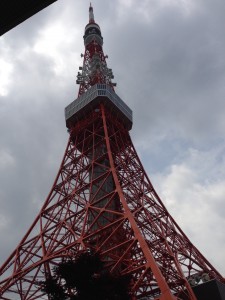
As the other Nakatani fellows and I boarded the plane for Narita, I had already started to notice changes in social etiquette. Interestingly, the attendant at our terminal in Houston referred to passengers using the higher honorific sama as opposed to san. I initially thought that sama was only used when one personally felt that the other individual was of a particularly higher standing. However, sama and other expressions of notable respect are commonly used by many businesses and services. For example, in a konbini, the staff greets all the customers by recurrently saying irasshaimase. It is meant to eagerly welcome patrons to the store – however lethargically they may say it at 11 p.m. – and succinctly illustrates ningen kankei in daily Japanese life. Prior to arriving in Japan, I was vaguely aware of this concept from watching documentaries and, of course, anime. I knew that certain behavioral codes existed in Japan and that they were meant to maintain harmony in society, but seeing them in person was still a culture shock. At many levels one can see how wa is intrinsic to Japanese culture, from the awareness of a single pedestrian to the orderliness of an entire subway station.
So far, language classes have been my favorite part of the day. Shweta, Youssef, Ben and I have had a different teacher each day and they’ve all been incredibly enthusiastic about teaching us Japanese. At first, I was fairly overwhelmed at having to internalize so much information, but I’ve been keen to match my teachers’ and classmates’ enthusiasm. Usually the other Nakatani fellows and I practice our Japanese while walking back from classes and we often practice speaking to the Sanuki Club staff. One thing that I’ve tried to do outside of class to improve my Japanese is noticing how native speakers, like Packard-san, Endo-san, Ogawa-san and the KIP students talk to one another. In class we often learn only polite and formal phrases. While they are valuable for speaking to someone of a higher position, like our professors, it is useful to also know more casual phrases for communicating with the KIP students and potentially our lab mates.
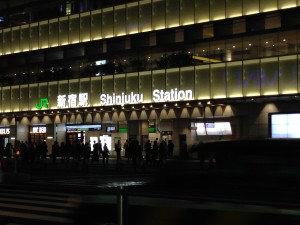
Even though it’s only been a week, I feel as if we’ve already done a considerable amount of activities. Our major outings were to the Edo-Tokyo Museum, Shinjuku station, the Nihon Sumo Kyokai Grand Tournament, and our lab tours at Tōdai. Going to Tōdai was particularly relevant for me because Tabata-sensei’s lab is on the same campus. It was nice to be able to get a feel for the campus before starting my research internship, although I will likely still get lost a few times. Something that pleasantly surprised me was seeing so many international students on campus. I’ve read that Tōdai is very highly regarded in both Japan and around the world so it attracts students from a multitude of countries. Even though my own university also has a strong international student presence, I’m curious to compare my experiences at UF with that of a Japanese university.
In addition to the outings, we’ve also had one seminar so far and a discussion with the KIP students on the U.S. presidential election. The Introduction to Science and Engineering seminar Kono-sensei gave helped me better understand the principles that govern nanotechnology. The concepts that arise when studying materials at such a small scale are definitely challenging to understand, especially because my main interests are in biology which typically operates at a larger scale. That being said, I’m glad to have had this opportunity to appreciate biology in a different context and ultimately enrich my knowledge with a better understanding of quantum mechanics. Since the research Tabata-sensei does is quite interdisciplinary, I’m sure the information I learned from the seminar will be applicable to my project in some way.
Question of the Week
One thing that I am curious about right now is what Japanese humor is like. Although I’ve seen anime humor, I’m sure it’s quite different from the kind people may use in daily situations. I think often Japanese people and Americans alike use humor to get to know others better and I’d like to be able to use the humor that the KIP students and my lab mates are familiar with as well as some of my own “American” humor.
On our lab tours at Tōdai we visited the Yamamoto lab, Mitsuishi/Sugita lab, and the Murayama lab. Yamamoto-sensei’s lab does research on electrostatic robotics and mechatronics. We had the opportunity to look at a few of their current experiments including their work on flexible electrostatic motors and haptic feedback devices. One of the experiments I found most interesting was the walking flexible motor robot, which exploited differences in thermal conductivity between two materials to initiate gait movements. The robot would be able to operate almost entirely independently, however there is a need to translate this work to lower temperatures that one would experience normally as compared to the experimental temperatures.
Mitsuishi-sensei and Sugita-sensei’s lab was more medically focused and their work was on remote laparoscopic surgery, in particular, neurosurgery. This method is quite useful for surgeons as it has much greater precision and reduces the operation time, thereby reducing the amount of time a patient spends in a hospital. Currently, the device they are working on has greater success on surface tissue and a system for deep tissue is still underway. Surprisingly, the graduate student who gave us the tour said that surgeons who’ve trained with the robotic system only need to practice for an hour! They must have a considerable amount of dexterity beforehand if this is the case.
Lastly, one of the experiments we saw in Murayama-sensei’s lab was about CFRP-made marine propellers. Their goal was to create an optimal structural design by choosing materials with high specific rigidity and specific strength. We had the opportunity to experience this difference in structural design firsthand in their lab testing facility. Considering the fact that I have little boating experience, it was interesting to learn from Murayama-sensei that boats that generate a lot of waves in the water underneath them are considered to have a bad structural design due to the presence of greater resistance. I’ll surely try to notice this in the future!
Kono-sensei also gave us a presentation on an “Introduction to Science and Engineering.” The lecture started with a discussion of metals and we gradually worked our way all the way down to quantum mechanics. Overall, we characterized metals, insulators, and semi-conductors via their electronic and optical properties. I found it helpful that the lecture was organized by scale, although as we went smaller and smaller I found that I understood less and less. Since my research interests aren’t usually discussed at that small of a scale, I don’t have very much experience with Nano scale concepts, and even less so with quantum mechanics. That being said, learning more about nanoscience is something I’ve wanted to do as an undergraduate and haven’t truly had the opportunity to do until now. While it is definitely up to me to fill in the gaps of knowledge that I have about nanoscience right now, it would be helpful in the future to have a little more discussion on biological applications.
Initial Research Project Overview
My research project at this point will use, loosely speaking, Terahertz time domain spectroscopy to characterize biological materials, especially genetic material like DNA. One major motivation for this is to better understand binding characteristics between proteins and nucleic acids since most of our DNA is studded with a variety of proteins that play a major role in genetic and structural function. As a result, most of the systems in my project will be analyzed at 3-dimensions. The techniques we will use allow us to better understand the electrical properties that are involved in bonding interactions, notably hydrogen bonding and London dispersion forces among others. Noteworthy applications for this research involves identifying abnormal tissue associated with Alzheimer’s disease, Parkinson’s disease, and a variety of cancerous diseases as well.
Research Paper Summary
I read “Application of Terahertz Wave Technology in the Biomedical Field“. The main purpose of this paper was to address the significance of Terahertz (THz) technology in biomedical research. Although the Terahertz band is often referred to as the “technology gap,” the energies associated with biological matter often lie in this region. As a result, biosensing technology can exploit this fact to improve our understanding of protein-nucleic acid interaction, antigen-antibody interaction, and other bonding properties. One major advantage of using THz technology is its ability to provide non-invasive imaging methods that exist at relatively small energies to avoid damaging the specimen. One method discussed in the paper is THz spectroscopy in which metallic meshes were used to examine the absorption of waves that match the vibrational energy of biomolecular interactions in a lectin-sugar chain. The transmittance spectrum was measured after varying the incidence angle of the THz wave. The results showed that the specific bonding between the types of sugars was successfully identified, and without the need for any chemical modification to the sample.
Week 02: Trip to Akita
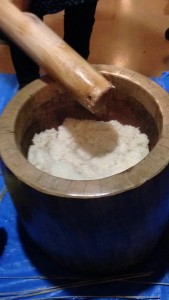
On our trip to Akita prefecture, the other Nakatani fellows and I were met with another opportunity to experience Japan for the first time. Although we’d been in Tokyo for less than a week, we’d already started to become accustomed to the daily norms of living in an urban Japanese city. On the other hand, exploring the rural side of Japan is something that even many tourists don’t get the chance to do. Like America, the urban and rural faces of Japan differ in more than just their landscapes – although admittedly, the biggest difference I noticed was the copious amount of rice paddies. Compared to Tokyo, people in Akita seem to be in much less of a hurry. Anywhere you are in Tokyo, people will be rushing past you on their way to catching the next subway train or crossing the street within seconds of the light turning red. While you’d never see that in Akita, that might simply be by virtue of a lack in public transportation. Although justifiably so, considering the distances we travelled in Akita were much longer than in Tokyo. All in all, Akita replicated most of what I expected out of a rural Japanese city: the quieter counterpart to Tokyo rooted in its traditions and its surroundings.
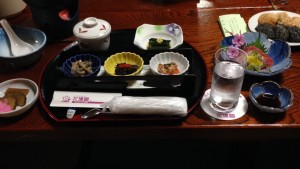
One thing I found most surprising on our trip was that vending machines were in no short supply, even in the most remote parts of Akita. Convenience is a common theme in infrastructure and development across the globe, but Japan takes it to a whole other level. While you may not be able to walk to a 7/11 in less than 10 minutes, the fact that several exist in such a remote region is proof enough. I think the rural and urban parts of Japan respect themselves as two separate entities. Urban areas across the globe, especially in Japan, are constantly developing and adapting to new trends, and some of these trends tend to spillover into the more rural areas. You would expect a great deal modernization to take place and uproot its heritage, but Akita still preserves a significant portion of its historical connections. When we visited Motsuji temple and Chusonji temple there were still active efforts to revitalize the community involvement. Rather than leaving these historical sites as stagnant monuments to simply take photos with, people can gather there to write poetry, celebrate festivals, and meditate. These and many of the historical sites we’ve visited thus far illustrate Japan’s efforts in preserving its cultural heritage.
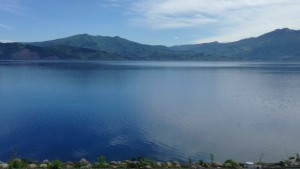
The biggest challenge I faced on this trip was probably going into the onsen. Being completely unclothed in front of other people is definitely something I’ve never done and never thought I would do. The first day I even refused to go because I didn’t feel comfortable, and the second day I think I only went because I felt like I was missing out. Truthfully, I’m still not sure if I’m entirely comfortable doing it yet, especially because I didn’t decide based on my own feelings, but rather from “peer pressure.” That being said, this experience has helped me reflect more about Japanese culture. My roommate, Yuko, is a KIP student and she explained that many Japanese people are used to it because they often do onsen with their families when they’re young. In the beginning I felt embarrassed, not just because of the onsen but also because I thought I was the only one who wasn’t comfortable going into the bath. In the end, I think I did enjoy the experience for what it was but more for what it taught me. Being in situations that challenge your previous perceptions are crucial, and these situations vary from person to person. This experience definitely made me feel a little isolated because I thought I was experiencing all the embarrassment alone, but I think to actually grow as a person you have to experience certain things alone. It’s helpful to be able to relate your feelings with another person at times, but when you experience something by yourself it establishes your identity. I know that while some of the struggles I’ll face in Japan will be the same for the other students, most of them I will have to face alone. It’s become almost instinctual for me to try and relate my problems with other people and while that may give me comfort in the moment, trying to experience hardships on my own is something I want to work on more in the future.
Upon returning to Tokyo, Azabu-Juban almost felt like home. It was a thrilling experience but I think we were all fairly exhausted by the end. In week 2 of language classes we began to learn different forms of conjugating verbs to shorten what we say. In the beginning, we learned how to make our sentences longer and more complex, but in Japanese, it’s preferable to use fewer words so we learned how to express the same idea by saying less. I think brevity is something common to English and other languages too; saying too many words does become quite cumbersome and hard for someone to understand. I’m truly enjoying learning all these phrases right now and each time I communicate with someone new I feel like I can sustain the conversation for a longer period of time before resorting back to English. Hopefully by the end of the summer I’ll be able to use minimal English in my conversations.
Introduction to Science & Engineering Seminar Overview
Professor Stanton’s lectures on semiconductors and Terahertz spectroscopy were quite helpful for me, especially because I don’t have an extensive physics background. After being lectured on band gaps again and also a few times in General Chemistry, I think I’ve begun to really internalize the concept. What I found most interesting was the discussion of scale. Whenever I think of things at an especially small scale, it’s hard for me to differentiate between “very small” and “even smaller.” I was taken aback by the fact that the ratio between 1 femtosecond and 1 second is the same as 1 second to 32 million years! A lot can happen in that amount of time and it’s critical that we develop equipment that can take measurements at increasingly faster rates.
Week 03: Noticing Similarities, Noticing Differences
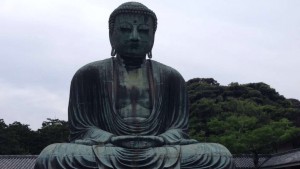
When it comes to understanding social behavior, you can’t get much better than good old public transportation. Whether it’s the bus or the subway, public transportation gathers people from nearly all walks of life with different purposes and different backgrounds into one common area for one common reason. At UF, if I can’t walk somewhere – which is most places – I almost always take the bus. Once I found out that I would be going to Japan for the summer, I tried to be more cognizant of the atmosphere in the bus because I knew that public transportation was a pretty big deal in Japan. I wondered how different it would feel to be a passenger in Japan versus America, and subsequently I realized that the biggest difference was that I didn’t look similar to anyone else there. While I don’t get stared at as much as I thought I would, the subtle glances in my direction are enough to feel a little strange. Aside from that however, there are a few notable things about how people conduct themselves in subways here.
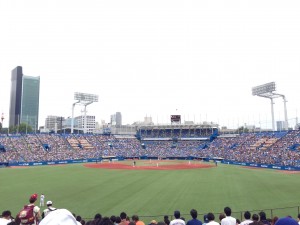
This was my and a few other fellows’ first baseball game. Ever. Even though we didn’t fully understand all of what was going on, it was a fun experience. Brianna and I did our best to keep up with the cheers though I’m pretty sure we cheered for the wrong team for a while. – Chandni Rana
The first is that everyone, and I mean everyone, is on his or her phone. Once I saw someone walk in to and get off the subway without ever looking up from his phone! Putting that amazing coordination aside, I think it’s a little unfortunate that most people like to stay within their own bubble. Even at UF, most people on the bus keep to themselves unless they are riding with someone that they know. But even people who travel alone tend to refrain from using their phones. It’s much more common in America for passengers to stir up some conversation with the person sitting next to them or even the bus driver. In some way, public transportation inadvertently creates social networks that wouldn’t have existed otherwise. Although, the fact that most people don’t talk on subways in Japan is really not an act of alienation. In fact, it represents an entirely different aspect of group interaction. Talking on the subway is generally perceived as disruptive and can prevent other people from listening to announcements or reading and concentrating on something. People will also be very careful to not take up too much room. No one has ever, to my knowledge, put their bag in the seat next to them, even if the train is mostly empty. Usually they will tightly clutch their bags to them so that they don’t intrude into someone else’s space.
By and large, however, what distinguishes subways in Japan from subways elsewhere in the world is what happens before and after you get off the train. In America, as soon as the train or bus reaches a stop, there will likely be a chaotic mess of people trying to get off and get on at the same time. This chaos then follows you as everyone rushes out of the platform together and stampedes up the stairs until finally the ticket gate forces everyone to (quite unsuccessfully) go one by one. It’s easy to justify this disorder by saying that people are in a rush and don’t have time to yield to other passengers. But seeing a Japanese subway station might make you rethink that. Everyone waits for the outgoing passengers to leave the subway car before entering. Then, everyone going in one direction up the stairs stays on their side and on the escalator people who are standing stay to the left to allow people on the right to walk.
Commuters in Tokyo are likely in no less of a rush than commuters elsewhere, so it’s actually quite astonishing that they can minimize disorder that would naturally arise. Yet again, Japanese people act in order to maintain harmony. While there is no direct interaction between them, the awareness that exists is its own form of silent communication that expresses the respect individuals have for one another.
Week Three Overview
This week we had lectures from Professor Bird, Aoki-sensei, Dr. Lyons from the NSF Tokyo office, and Dr. Shimizu-Guthrie. I especially enjoyed Dr. Bird’s lecture on working as a foreigner in Japan. Usually most people will give you very diplomatic answers to topics like this so I appreciated the honesty in his lecture. While each of us will have a different experience here, I think it’s true that since we are all not Japanese, we’ll be treated quite differently from the other members of our lab. In some ways it’s a good thing because everyone may be more understanding of our mistakes, but at the same time it makes it difficult for us to be accepted as just another lab member. Dr. Lyon’s lecture on “science diplomacy” was quite the eye-opener for me. When I initially applied to the program and came to Japan, I admittedly thought about how this experience will benefit me for the most part. I knew that the program played a much greater international role, but I never really felt like I was an important factor to this. I realized after Dr. Lyon’s lecture that we aren’t just students or researchers in Japan. We are also diplomats. The impressions and relationships that we make in Japan are all part of a greater effort to increase collaboration between two nations. Even though we are only individuals, the role that we’ve been given as “unintentional diplomats” is not one to be taken lightly.
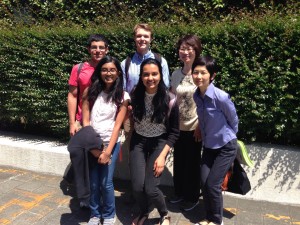
On Friday, the Nakatani fellows and I had our last language class and presented our speeches to each other and our teachers. Afterwards we all went out for lunch. Even though I’m glad that I got to learn so much of the language, I’m worried that I may not be able to learn as much during my internship as I did in these three weeks. I think it all went by so fast because I really enjoyed going to class. I’ll especially miss all of my teachers! They’ve all helped me so much and I hope that if I meet them I can show them all of the new phrases I’ll learn.
Research Internship Update
Aoki-sensei and Professor Bird’s lectures on nanoscience covered more material on semi-conductors. I think Professor Bird’s lecture on Graphene as a semi-conductor really helped me understand why Graphene is of such importance to the field of solid state devices.
Week 04: First Week at Research Lab
My first day in Tabata Lab at the University of Tokyo was much less busy than I thought it would be. First Tabata-sensei showed me the three rooms that belong to our group: one is his office and the other two are where the assistant professors and students work. I got to meet a few of my lab mates and after that I mostly stayed at my desk and read some papers. I’d already met my mentors the day before since they helped me move into my apartment housing. I felt so fortunate that Tabata-sensei actually assigned me two mentors for my internship period: Lili-san, who is my “daily life” mentor, and Uematsu-san, who is my experiment mentor. Lili-san is also an international student at Tōdai from China. I feel like we have a lot in common since we are the only females in the lab and we prefer to communicate in English since we’re still learning Japanese. Even though Lili-san is my assigned life mentor, I think Uematsu-san has also helped me a lot with my living adjustments. He is also new to the lab and has actually only been there for two months. I eat lunch with at least one of my mentors most days and we often talk about the differences between our universities. The other lab members are also nice but I think they might be a little shy so it may take me some time to become better acquainted with them. One reason for that may be the language barrier. Hopefully I can improve my Japanese and be able to communicate with them better as time goes on. My mentors speak English quite well though, which is a relief since I will be talking to them most of the time.
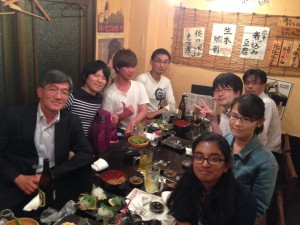
Earlier in the week I asked Tabata-sensei if I could make a short presentation about myself for our weekly lab meeting and he liked the idea. I thought that officially introducing myself to my lab-mates might make it easier to get to know each other. At first I was a little scared because I didn’t know how they would receive my presentation. I didn’t want it to be too formal since that might create some distance between us, which is the opposite of what I wanted. But at the same time, I was unsure of my lab’s disposition and whether they would appreciate a more informal presentation. This was probably my first challenge in navigating unfamiliar cultural waters and luckily it all went through quite smoothly. Everyone seemed to enjoy it and I even got some questions! I was especially glad that they liked my omiyage! Afterwards, we all went to an izakaya for my welcome party. It was nice to get to know Tabata-sensei better during this time. One interesting thing I learned from him was that the reason why Tōdai attracts so many international students is not just because of its global ranking, but also because of a bilingual program that was put in place to remove language barriers. Students who aren’t native Japanese speakers will take a class first in English and then the same class in Japanese. The first time around they can learn all the information and the second time helps them learn Japanese. This also works in the reverse way for Japanese students who want to improve their English.
My internship housing is in Uguisudani, which is around 20 minutes away from Tōdai by train. As of now, I usually get to my lab by taking the train/subway but I’m planning on biking instead. My room is much bigger than I had expected and a lot bigger than the rooms we had at the Sanuki Club. Luckily, it also came equipped with a mini fridge so that I can keep some food in my room. The building itself looks fairly old and is unfortunately located on a busy street so it tends to get a little noisy, but I’m getting used to it.
After arriving at the lab, I was told that my research project would actually be on using Terahertz time domain spectroscopy to measure creatine rather than protein-nucleic acid interaction. I initially thought that the focus of my project would be DNA since most of my papers discussed using THz spectroscopy for DNA analysis, but it was more of an introduction to past experiments that demonstrate how THz spectroscopy can be used to characterize biomolecules. I think creatine is an interesting topic to study, mostly because I am not too familiar with many diseases or abnormalities related to it. Since my mentor is also quite new to the lab, rather than joining an “on-going” project like I did with my lab at UF, I will get the opportunity to participate more early on. As a result, a lot of my work is independent and I receive much less guidance than I’m normally used to.
Orientation Program Overview
The orientation program did an excellent job of introducing us to Japanese culture. Although what we’ve learned is only a small fraction of what really exists, I still feel very well equipped to independently stay in Japan. My favorite part was, of course, language classes. I felt like the experience did so much more than just teach us how to communicate in Japanese. Even though all of us hardly knew each other before coming to Japan, going to language classes brought all of us together more than we realize. We got the opportunity to learn something intrinsic to Japanese culture, and the best part was being able to share that experience with each other. Going forward, I definitely plan to keep practicing Japanese whenever I can. I’ve already learned some new phrases from my lab mates that I’m excited to start using! I think these new phrases will be especially useful since they are used in more casual conversations.
Out of the first three weeks, though we experienced so many things, I found the sumo tournament and Dr. Shimizu-Guthrie’s lecture to be particularly memorable. Being a sort of Japanese culture enthusiast before coming to Japan, I already had some knowledge on all the activities we did… except for anything related to sports. I think sports are a topic that I tend to neglect quite often, likely because I never had much interest in it growing up. After attending the sumo tournament, however, I realized that it is so much more than just a physical competition. Sumo challenged class boundaries in that no matter what social class the player came from, in the sumo arena, everyone had a chance to rise to prominence. Given that the class system that in Japan was so rigid, it seems anomalous for an arrangement like that to have existed. Dr. Shimizu-Guthrie’s lecture on baseball linking Japan and America during wartime was also an eye-opener for me. When I think of baseball on a day-to-day basis, I think of it as just another American sport. I never considered it to be one of the binding factors that brought America and Japan together after World War II. I realized that sports can act as more than just activities and entertainment, they are catalysts for social and economic change at even an international scale.
Question of the Week
In general, how do most people in Japan perceive America? After I gave my introduction presentation to my lab, I learned that Tabata-sensei has actually been to Florida several times. He told me that when he was in university, many people in Japan thought of America as being sort of “unsafe.” After he came to America himself that preconception was challenged. I wonder if many other Japanese people still share that feeling. If they do, why? What sources have led them to believe this?
- For an interesting perspective on what Japanese undergraduates think about the U.S., you might want to read the student profiles and weekly report excerpts from the 2016 TOMODACHI STEM @ Rice University Program. These 10 Japanese undergraduates participated in a 5-week research internship experience in the U.S. and many of their weekly reports reflect on various aspects about the U.S. that they were surprised by or were interested to learn more about during their time abroad.
Research Project Overview
Since some research on Terahertz time domain spectroscopy and DNA has already been conducted, our research focus shifted to analyzing creatine, which is not as well understood. Creatine is a nitrogenous acid synthesized from glycine and arginine and is essential for skeletal muscle function. It is also converted into creatinine in the body that is neither absorbed nor secreted in the urinary tract and consequently acts as an indicator of urinary health. The three samples we have to work with right now are creatine, creatinine, and phosphocreatine. Prior to receiving our creatine samples we did some trial runs to measure the background data at varying humidity levels. It was beneficial to do so in order to confirm some past experiments that also involved using Terahertz spectroscopy at varying levels of water vapor. Our goal is to ascertain whether creatine has a distinguishable absorption spectrum, especially in the presence of water and other proteins. In vivo creatine is almost always dissolved in solution, which proposes a challenge for measuring its unique absorption spectrum since the hydrogen bonding energy between water molecules exists in the Terahertz region. This activity could potentially interfere with the creatine spectrum and make it difficult isolate the creatine sample. Hopefully, by obtaining a unique Terahertz “fingerprint” for creatine, we can help create cheaper and more effective methods of determining creatine concentrations.
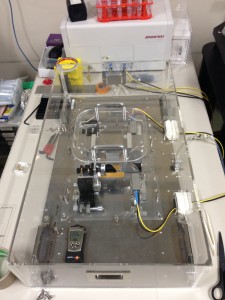
For our experiments we will be using a TAS7500 Terahertz Spectroscopy Imaging System. The three methods that one can use to image a sample via THz spectroscopy are transmission, reflection, and total reflection; however, total reflection isn’t necessary for our project. The method that we use depends on the sample material and whether it has strong absorption in the THz region. If so, transmission yields a better signal. If not, then the material tends to reflect the THz wave and thus reflection mode is more appropriate. Additionally, our setup will use a metal meta-material in order to enhance the sensitivity of the system. For our experiments, we will measure both solid and dissolved creatine samples and observe the absorption spectra as we vary the concentration of creatine. It is anticipated that varying concentrations will yield characteristic absorption spectra necessary for diagnostic purposes.
Following this initial experiment, we anticipate being able to further analyze in synthetic plasma and urine environments. For now, I mostly shadow my mentor whenever we use the THz system but hopefully in the future I will be able to perform some experiments on my own. Until then, we are still in the process of becoming more familiar with the creatine’s biochemical pathways so that an appropriate place for intervention with the THz spectroscopy can be determined.
Return to Top
Week 05: Critical Incident Analysis – Life in Japan
Before we all went off to our research labs, the Nakatani fellows and I were already in communication with our labs. While we were all arranging transportation to our internship housing, I had to send an e-mail to my mentors about how we would all meet. We initially planned to meet at Shinjuku Station and then go to the housing office from there; however, a student from Maruyama sensei’s lab was coming to pick up Brianna and he kindly agreed to help Sasha and me get to the housing office as well. Since this changed our initial plans, I had to ask Uematsu-san and Lili-san if it would be all right with them to meet at the housing office instead. At that point, I’d only been in communication with Tabata-sensei and my mentors via e-mail. Anyone who’s had to send e-mails to a higher ranked person knows that it’s not as easy as a click of a button. It’s tricky to find the right combination of professionalism and friendliness without creating an awkwardly worded mess. In this case our cultural differences made it even more challenging to phrase things exactly right and to not imply something unwanted. So, I decided to ask Packard-san if she wouldn’t mind reading over my e-mail. I knew that she would know the best way to approach the situation so I really appreciated her taking the time to look it over.
The first time she read it through she told me to put my “thank you” in the beginning rather than at the end. By doing so, you are implicitly prioritizing your gratitude to the other person over anything else you may have to discuss. Originally, I always ended by saying “thank you,” mainly out of convention, but also because I thought that this way the reader would keep it in mind for longer; however, I may start doing this in similar future e-mails. I think it’s true that how someone feels when they first start reading your e-mail can change how they perceive what follows. Afterwards, we decided that it might be a good idea to also end by saying “thank you.” While this is universally be considered to have good intentions, it might be where the line between American and Japanese e-mail etiquette is drawn. In America, overly repeating your “thank you” is likely taken as coming off too strong, and frankly, unnecessary.
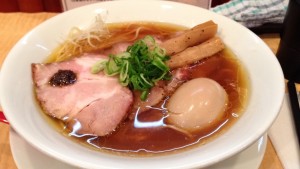
In light of this advice, I made some changes and asked Packard-san to look it over again. This time she said that the tone of my e-mail might have been too forceful since I was “notifying my mentors of a change in plans” rather than “imploring them to indulge my self-interest.” I think a lot of Western readers may find that a little puzzling, and it is likely cultural differences that may lead us to feel that way. At first, I was also confused because I didn’t see how I was being “selfish.” I thought that I was just asking for a simple request, and I thought that it may be easier for both parties. My intention was just to simplify the process, but I suppose I really wasn’t thinking about how it may affect Uematsu-san and Lili-san. Just because it would be easier for me, it doesn’t necessarily mean it would also be easier for them. I naturally assumed that because they lived in Tokyo, they wouldn’t have any trouble finding our meeting place. In contrast, I wasn’t as confident in my navigational skills. At the same time, I assumed that since we would be going to the housing office together anyway, it wouldn’t really matter if we met up directly there. But, that is likely only the Western mode of thought. They likely thought that, navigation-wise, it would be easier for me to meet at the station than the office. There’s a lot of possibilities, but the biggest reason why I was advised to sound a little “submissive” was probably because they were my seniors. There is always a hierarchy, and it should always be respected. In some cases, it isn’t unusual for the hierarchy to even trump efficiency. Although, fortunately this wasn’t the case for me. In Japan, speaking in this manner decidedly minimizes the chances of a conflict. By saying “selfish” or “self-interest” in an e-mail, it’s also important to remember that it doesn’t have the same meaning in Japan as it does in America. It doesn’t really mean that you’re selfish or that you think you’re selfish. It just expresses your humility and respect for the other person’s rank. Even before I came to Japan, I think I already talked a little submissively in most of my e-mails to superiors. Consequently, I felt that I didn’t really have to change my tone that much for my Japanese professors and mentors. It seems like in America it is natural to also be submissive to your superiors in the beginning, but after a while maintaining that submission will make you appear a little standoffish. In Japan, this behavior has to be much more convincing and it’s less common for it to fade as time goes on.
I think this was the best example of cross-cultural communication I experienced. Even though it wasn’t necessarily a conflict – and it was technically “pre-communication” – it was certainly a moment where I bumped up against my Western mentality the hardest. What I thought was just a simple request ended up being a greater lesson in cultural communication. I really appreciated Packard-san giving me this advice because even though person-to-person communication in a another culture may be hard, writing e-mails is also its own skill to master.
Question of the Week
Concerning student/teacher relationships, are there cases of students and teachers treating each other more like “friends”, similar to what’s observed in America? Do teachers ever see their relationship with their students as more than just professional?
Research Project Update

This week, my mentor and I came up with a definitive project goal. The main focus of the project is more on metamaterials rather than creatine or creatinine. Although we will be imaging them, our main research problem will focus on trying to fabricate various patterns of metamaterials to enhance the THz signal. If we develop a successful pattern, our next step is to compare our technique with other imaging methods like Raman spectroscopy and SERS. As of now we decided on three main patterns and this week I had the opportunity to participate in the metamaterials fabrication process.
For the first step we had to go to clean room in order to use the photolithography machine and create the first layer for our metamaterials. First we have to clean our sapphire substrate “wafer” by submerging it in acetone and sonicating for roughly 3 minutes. After that we “bake” or heat it to eliminate any moisture that may still be there from the cleaning process. Then we apply a negative photoresist coating to make parts of the sample more sensitive to light and then heat it again to eliminate moisture. After that we expose the sample to UV light and the parts of the sample that weren’t exposed to the UV can be removed during developing. Following the photolithography we have to use the sputtering machine to deposit gold particles onto the surface of our sample.
Ironically, we encountered issues with this process rather than the photolithography even though it is much less complicated. To use the sputtering machine we can only put a limited amount and size of samples at a time. Our first batch came out well but during our second run we couldn’t remove the samples from the machine. It really wasn’t too much of an experimental setback and more of a technical error since we neglected to adjust the pressure of the Argon gas entering the system the second time.
Once our metamaterials were made we were finally able to use the THz system to image our samples. So far we’ve tested our three metamaterial patterns with both horizontal and vertical polarization and solid samples of our creatine and creatinine. So far we’ve only used the transmission data from the system and next week we are planning to also get data from the reflection set-up. Right now my mentor and I are still working on analyzing our current data, but soon we will try to work on creating more patterns for the metamaterials and seeing how they can affect the THz absorption spectrum.
Return to Top
Week 06: Preparation for Mid-Program Meeting
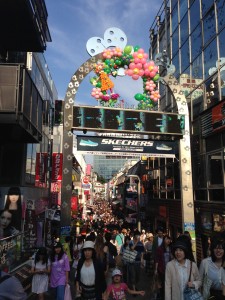
I mentioned earlier that using the onsen was one of the biggest challenges I’ve faced since coming to Japan, but it’s definitely not the only one worth mentioning. Daily life in Japan gives rise to its own set of challenges. Forging your niche in a new country is a slow process and even two months is hardly enough time do it. It’s as if you have to build your life again from the bottom up. First you have to figure out how you’ll get meals, and if you decide to cook there’s the issue of having to adapt your diet to ingredient availability. Then you have to figure out transportation. After which you have to convert all the cleaning, health, and hygiene products you’re used to using into a new foreign brand. All while remaining within your budget and doing all of this in another language. Not to mention the frequent bouts of homesickness.
However daunting they may seem, none of these things really posed as big of a challenge as one thing in particular. From establishing a routine to keeping up with research to even communicating with people in Japanese, the biggest difficulty, in all honesty, is the staring. Whether I’m in the subway, or walking down the street, or even when I’m on campus, a day hasn’t gone by where I wasn’t stared at as I passed someone by. It’s a constant reminder that no matter how much of the language you learn, or how well you adapt to the social etiquette, you’ll still be different. The truth is, even after you finally accept a new place as your home, it still takes a while for it to accept you back. Living in a place as homogeneous as Japan makes it especially difficult to integrate yourself into the culture. Some residents in Japan haven’t even interacted with foreigners before, so getting them to think of you as just another person is pretty unlikely. It’s completely different from the “no matter where you come from, you’re American” mentality I’ve grown up with. Back home I’m still a demographic minority – arguably less so than in Japan – but I don’t often feel like one. The difference is that here, not only am I probably the only Indian in the room, I might be the only non-Japanese person too. While I’m definitely not trying to make any implications about Japan being austere, I think it can be unintentionally alienating at times.
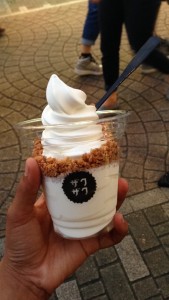
I think that’s why my biggest accomplishment was my omiyage. I felt like it was one of the first things I would be judged on by my lab. In fact, I was so anxious about how they would receive my omiyage that I rewrapped and changed the packaging at least three times. I wanted to show my lab members that I was someone who wanted to do more than just work on a project for two months. I wanted them to see me as someone who was willing to learn and adapt to their culture. Ultimately, I’m not really sure what my omiyage expressed to each of them, although they all seemed to appreciate it. I guess I was hoping that this one action would do everything, but it takes a lot more time and effort to express the sincerity I wanted convey. I think lately a few of my lab-mates and I have already started to become much closer and I’m looking forward to getting to know them better as time goes on. I suppose that while they may never accept me like they would another Japanese person, somewhere in between that and “foreigner“ is enough for me.
Question of the Week
How are foreigners from other countries treated in Japan compared to Americans?
- If there are international students in your lab, this would be a great question to speak with them about to learn more about their own experiences as foreigners in Japan. You might also find the following articles interesting:
Research Internship Update
This week my mentor and I worked on analyzing the transmission data for the three metamaterials that we used in our experiment. Following the experiment and after reading a paper on this phenomenon, we observed that as the iterations of triangles in the photo mask pattern increases, the spectrum becomes redshifted i.e., shifts towards a lower frequency. Right now we are going to use finite-difference time-domain (FDTD) software to obtain simulation data for our metamaterial patterns. Aside from this, we are still in the process of determining which material would best enhance the THz signal for creatinine. Usually, the resonance frequency of the sample is already known and the appropriate metamaterial can be fabricated to have a characteristic length that reflects this frequency; however, the resonance frequency for creatinine hasn’t yet been determined.
Lately I’ve had a lot of downtime in the lab since Uematsu-san usually has to attend classes most days. So, I’ve decided to join Lili-san on some of her experiments to get some more experience with the lab equipment. Her project is focused on exposing muscle cells and osteoblasts to electrical and magnetic stimulation and observing their effect on cell differentiation. Since her research is much more biology-oriented than most everyone else in the lab, I’ve had an easier time understanding it compared to my own project. Since she will be completing her thesis this month, she’s also been busy with experiments so hopefully I’ll get more opportunities to participate.
Return to Top
Week 07: Overview of Mid-Program Meeting & Research Host Lab Visit
This past week all of the Nakatani-RIES fellows and program staff got together in Kyoto for our Mid-Program Meeting. After a month of mostly talking in either broken Japanese or “modified English,” speaking like a normal person for more than a few hours was a nice change. I didn’t even realize how much I needed it until we all started rambling about our lab experiences on the bus ride to the seminar house. Everyone was so eager to share their stories! Some were outrageous, some were uplifting, but most were just plain funny. On top of that, I also didn’t realize how much I could miss a bunch of people who I’d only known for three weeks. Our three days together flew by more quickly than I expected, but it was a pleasant break from the usual lab routine.
One of the first things we did at the Mid-Program Meeting was share an overview of our research at Kyoto University. It was intimidating to have to present to some of the more well-established scientists, but invaluable to learn what kind of questions to expect from an audience like that. Afterwards we toured some of the labs at Kyōdai and visited Ginkakuji in the afternoon. I really enjoyed touring these labs because they were oriented more towards biological sciences. One lab even did research on learning and memory! Lastly, we ended the day with a barbeque to celebrate the Fourth of July.
We spent the next day doing several cultural excursions, including our visit to Kamigamo shrine, Kinkakuji, and participating in a tea ceremony. Later that night we got to do hanabi and what I was most looking forward to: wearing traditional Japanese yukata! I’ve always found yukata and kimono to be incredibly beautiful with how they could seemingly capture all of Japan’s vividness on just a few pieces of fabric. I couldn’t wait to wear one, and once I saw all of the amazing patterns laid out for us I welled with excitement. While I’d love to say that everything went smoothly and I got to wear the yukata of my dreams that night, that’s not exactly how it all happened.
In reality, I got the pattern that I wanted least. It probably sounds childish to even care about something like that, and of course if I really wanted to wear a different one I could just buy one. But at the end of the day, I don’t think it was about the yukata at all. The real issue was my tendency to have too many expectations and then get disappointed when things don’t turn out the way I imagined. I think Horikawa-san’s daughter and wife, who had graciously agreed to help us wear the yukata, also knew that I got a pattern that I didn’t really have a liking towards. Afterwards, when I asked Horikawa-san’s daughter what the different colors and patterns of the yukata symbolized she made it a point to tell me that she felt my yukata suited me better than the others would have. I know she was probably just saying it to make me feel better, but I felt horrible inside. I didn’t want them to think that I was ungrateful for what they had done for us. Sometimes it hurts when we do things that we know will ruin our day, but it feels a lot worse when we potentially ruin someone else’s too.
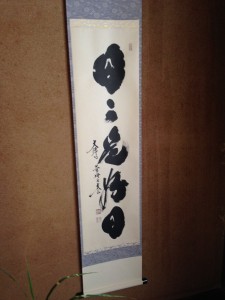
At that time, I couldn’t help but think about the poem we saw at the tea ceremony earlier that day. Japanese tea ceremonies traditionally have a calligraphic scroll hanging in the room inscribed with either a short poem or word to reflect the season. It’s the aspect of the tea ceremony that I found to be the most meaningful, and especially so that day. It read, “don’t have too many expectations for the future, just try your best for today.” It doesn’t align perfectly with my situation, but I think it’s true that expectations aren’t always a good thing. Sometimes it’s best to just accept what you’ve been given one day and make the most of it.
On the last day we visited the Sysmex Technopark in Kobe. It was a beautiful site that effortlessly combined old with new. Inside the buildings everything was designed to be sleek and modern, but outside in the gardens you could travel back to Japan’s ancient roots. I definitely envy the people who work there, although apparently many of the Japanese workers don’t really take breaks to enjoy the spectacular gardens! After lunch, which consisted of Kobe beef sandwiches, we took a tour of the Technopark and silently all wished we could work there.
Finally, we traveled to the train station and it was time to say otsukaresama deshita and head back to our labs. It was a little disheartening to say goodbye to everyone that day. From rambunctiously playing card games in the hotel lobby at night, to unapologetically disturbing passengers on the subway, the Mid-Program Meeting was just what we all needed: a chance to feel a little American again – well… intentionally, and in the company of other Americans.
Following the Mid-Program Meeting, Kono-sensei, Sarah-san, Packard-san, Endo-san, Ogawa-san visited the Tabata lab on Friday. First we all discussed my progress on my research project and then a few things about my daily life. Afterwards we took a look at our THz system and the clean room (from the outside) where I fabricated our photo masks for the metamaterials. Tabata-sensei also showed Kono-sensei his MBE machine which he was quite interested in! During the lab visit I shared with everyone that I also joined Lili-san’s experiment to get some more experience in the lab and we all decided that it would be interesting for me to work on a project that involves nerve cells. I’m not entirely sure what kind of project we will work on, but I’m definitely excited to start working on it!
Research Project Update
This week we created dilutions for our creatinine samples, consisting of 1%, 3%, 5%, 10%, and 20% weight percentages. Just today we tested our samples with the THz system and unfortunately it seems that our results aren’t quite precise, with each trial being staggeringly different from the last. Not to mention that the 10% and 20% samples are not completely dissolved, even after extensive vortexing and sonicating. I’ve thought about this and I think we may not actually need concentrations that high if the threshold for diagnosing renal failure is much lower. While we solve some of the problems with my first project, we’ve yet to even start my second project. Right now the possibilities for what I could work on are still up in the air. I’d personally love to do something involving nerve cells but ordering them might take a while and I wouldn’t want to waste the lab’s money by ordering them on a whim. Lili-san and I are currently trying to find other labs that use nerve cells and seeing if we could borrow some from them. Apparently, a student in our lab did actually use nerve cells for his research, but he left the lab 10 years ago. After digging through the freezer we only found bone cells, blood cells, and muscle cells, so those cells are still a mystery.
Moreover, Lili-san mentioned to me that Tabata-sensei told her that using THz to optically image her cells after exposing them to stimulation might be something she would want to look into. Since she’s busy with her thesis she hasn’t really had time to complete this project but, time/resource/luck-permitting, I can hopefully work on this project for the rest of the summer. Now there’s only the issue of figuring out how to make one poster out of two different projects.
Week 08: Research in Japan vs. Research in the U.S.
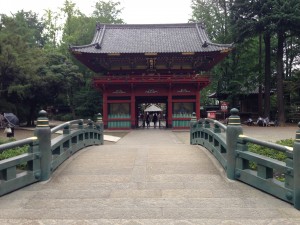
Concerning laboratories in the U.S. and Japan, etiquette is probably the biggest distinguishing factor between them. In the U.S., my lab rarely has the same level of formality that I’ve experienced here. Even though both have hierarchies, the extent to which they are defined and acknowledged is noticeably different. And the place where that’s most evident is at lab meetings.
Every Thursday the Tabata lab gathers in the conference room and two members share the progress they’ve made with their research. The meeting lasts roughly 2 hours, with one hour for each presenter. First there is a 30-45 minute presentation, and depending on who is presenting, it will either be in English or Japanese. We have two Chinese students, Cho-san and Lili-san, who prefer to speak in English when they are presenting, although Cho-san normally converses in Japanese. Everyone else always gives their presentation in Japanese. The remaining time left after the presentation is allocated for questions and Tabata-sensei’s feedback, which is where things become really different. Uematsu-san (my mentor), who usually moderates the meetings, will announce if anyone has any questions. Then there’s a pause while everyone tries to understand all of the information. Finally, someone asks a question and once the presenter is done answering there’s more silence. This continues for x number of people who have questions until Uematsu-san, by some nebulous ability, notices that no one else has questions and says that it’s time for Tabata-sensei’s feedback. Before Lili-san gave her presentation a few weeks ago, I wasn’t really able to tell what Tabata-sensei’s feedback was like since it was all in Japanese. But once I did, I was actually quite surprised. I initially thought that Japanese professors were (ironically) much more direct towards their students, but this preconception was mostly based on anecdotal evidence. In reality, most of Tabata-sensei’s feedback was actually not harsh at all and the critiques were phrased more like suggestions. Moreover, his feedback discussed not only research progress but also the presentation and how the information should be conveyed. Lastly, Uematsu-san ends the meeting by saying otsukaresama deshita. We all slightly bow and repeat after him.
It’s probably quite evident already, but meetings in the Tabata lab are quite methodical. In contrast, those in my home lab are staggeringly different. Meetings may be important for sharing progress and receiving feedback, but giving us a time to bond and form relationships with each other is their greater role. To illustrate, we often struggle to keep to the agenda since everyone will frequently go off on tangents about what they did on the weekend or some funny incident at a recent conference. Each week someone new has to bring breakfast for everyone and we often plan activities to do together as a lab. Both labs have completely different atmospheres, but at the end of the day, they are both oriented towards one main goal: research.
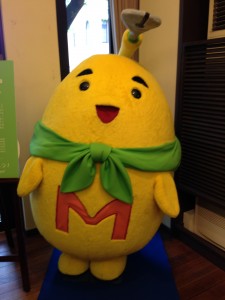
Every lab wants to make advances and contribute to their field. And Japanese labs and American labs have different approaches to this. From what I’ve gathered, it seems Japanese labs are much more focused on building a coherent story to their research: why are we doing this research, what problem are we trying to solve, how does this research contribute to society? In America, while we share many of those concerns, the questions we regularly ask are a bit different: what’s the most efficient way of doing this and, of course, how much does it cost? I’m not really sure which environment I would prefer, but I think my ideal lab would be one that combines the social atmosphere of an American lab with the research approach of a Japanese lab.
Ultimately, you can find a multitude of differences between labs in Japan and America. Graduate students, however, are not one of them. Stressed-out, over-caffeinated, and sleep-deprived is a common theme of graduate students the world over. They may wear their stress differently – and usually drink tea instead of coffee – but they are easily identifiable from the crowd. Plagued with uncertainty, struggling to read papers they only half understand, roaming around the equipment with half-baked ideas of what to do next, it’s clear that Japanese and American grad students bear many of the same burdens that come with doing research. It’s one of the similarities that I found to be just as reassuring as it is comical. Even though we have different perspectives and approaches to how we solve problems, there’s no right way to do research. It’s stressful and unpredictable no matter where you are in the world. Both countries have drawbacks and the best way for us to overcome them and achieve our goals is to collaborate with each other.
Question of the Week
A majority of my lab members are master’s students who are currently in the process of job hunting. For them and many students in Japan, getting a master’s degree is just another step on the path to an industry job. One of my lab members just got a job at SoftBank, which is a telecommunications company, but his research involved using THz-TDS for analyzing vitamins. Given the discrepancy between his research and his new job, why is obtaining a master’s degree so crucial when it often seems to provide little intellectual value in one’s career?
- A part of this is that starting salaries for those with a master’s degree are higher than for those with just a bachelors, no matter what field you are in or industry you go into. Also, education in Japan doesn’t train you for a career; rather the companies who hire you expect that once they hire you they will train you and tell you everything you need to know about the (Company Name) way. For more on this see the websites below:
Research Project Update
Since I just wrote my last report yesterday, there haven’t been any major breakthroughs worth mentioning in my project yet. Uematsu-san and I didn’t do any experiments today but we did attend a lecture from Dr. Josep Fontcuberta who is a researcher in Spain at the Institut de Ciència de Materials de Barcelona (ICMAB). His talk was on magnetic materials and devices but he mostly focused on oxide materials. This was useful for many other members in my lab who are developing biosensors using oxide materials. While I struggled to understand his lecture since it is a completely different area of research from my own, I did learn a few interesting things. Notably, he mentioned that one of Curiosity, one of NASA’s Mars rovers, ran into the issue of degrading flash memory on account of unwanted radiation altering magnetically stored information. I never realized that a lot of our information is actually stored magnetically and this makes it susceptible to tampering and even erasure. He explained that the solution to this was to use antiferromagnetic materials which aren’t sensitive to magnetic fields and can retain memory much more reliably. While I didn’t really understand all the theory behind it, I still think I learned a few useful pieces of information from his lecture.
On another note, today, Yamahara-san (our post-doc) and I discussed how I should proceed for my new project. We decided that ordering new nerve cells might not be the best idea since they won’t arrive until next Tuesday at the earliest. Not to mention no one else in the lab uses nerve cells for their experiments. Instead our plan is to first use THz-TDS with our metamaterial to analyze various concentrations of cells. I’m excited to start working on it tomorrow since I will finally get the chance to fabricate metamaterials again, and this time on my own! Hopefully I can obtain some presentable data for my poster. If all goes well, I might be able to advance my project to encompass Lili-san’s as well, in which I can use the THz-TDS to analyze her cells before and after their differentiation to observe any characteristic changes in the transmittance plots.
Week 09: Reflections on Japanese Language Learning
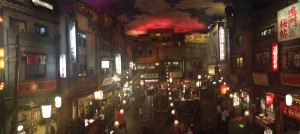
Learning Japanese this summer has been one of the most rewarding experiences I’ve ever had. Having a working knowledge of Japanese makes it infinitely easier to do daily activities, whether its reading maps or reading menus. When we first arrived in Tokyo, I remember paying really close attention to the screen on the subway, trying to make sure I could read all the information while it was still displayed in English. Now, I find it’s actually not too difficult to read the information in Japanese as well. There might always be new Kanji to learn, but knowing some basic ones goes a long way. In fact, the place where language is my biggest obstacle is actually lab meetings, although I like to think of them as my “weekly Kanji test.” Usually, I end up spending most of my time trying to find Kanji characters that I can recognize on the handouts and also learn some new ones. More importantly though, I’ve made some noteworthy discoveries about how certain concepts are taught and understood in Japan.
For instance, a few weeks ago, Yamahara-san gave his lab meeting presentation on spin wave resonance. The word “spin” was (surprisingly) written in Katakana, while “wave” and “resonance” were written in Kanji, i.e. “spin,” which seemed to me like a universal concept, was written using the syllabary for foreign words. On the other hand, “resonance,” which seems more foreign, was written in traditional Chinese characters. Bemused, I consulted a few of my lab mates, until finally getting an answer from Google-sensei. From my understanding, because “spin” in that context didn’t really refer to the action of spinning, but rather to a quantum mechanics concept, it was written in Katakana. Apparently, Katakana is used not only for words that really are foreign, but even for words that “feel” foreign (and also a few other reasons). Likewise, “resonance” is not so much of a foreign concept, since it is actually composed of the Kanji for the words “ringing” and “together.” Learning Japanese gave me the ability to do more than just read three words that day. It was almost like a moment of brief insight into the Japanese mindset. It really doesn’t all end with grammar and vocabulary; there are lessons to understand beyond what is just written on paper. Not to mention, nowadays it’s easier to just use Google Translate or use Google Maps to find how to get somewhere, but there’s so much more you can learn by trying to piece things together yourself.
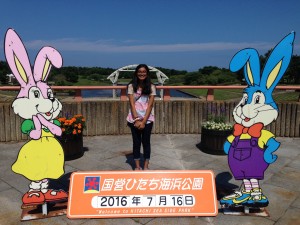
One thing I’ve really enjoyed doing is going back and listening to some of my favorite Japanese songs that I didn’t understand at all before. Now I can fragmentally translate several parts. It’s a lot easier to remember words when you hear them in songs and I’ve learned so many new ones this way. Learning slang words from my mentors and some of the new friends I’ve made here has also been helpful. For example, maji is one of the slang words that Uematsu-san taught me, and it’s supposed be used for emphasis. Literally, I think it’s translated to mean “very.” Just walking around on the street I actually hear it quite often from adolescents. A few days ago, however, I was sitting on the train and these two tall – and somewhat intimidating – men dressed in black yukata walked into the car and stood right in front of me. They were big enough to completely block my view of the window across the aisle. Both of them were glued to their phones, probably scrolling through Facebook, until one of them shrieked “OH, MAJI KAWAII (THAT’S SO CUTE) !” at a photo he saw. The other one grunted in agreement. My initial impression of them completely dissolved as I fought to hold back laughter.
Before coming to Japan, I was admittedly scared about not knowing much Japanese. I could see myself getting into awkward situations with passers-by or convenience store workers, but it’s really much more entertaining than it is embarrassing, and definitely no reason to avoid traveling. Overall, I feel like I’ve become better prepared to not just come to Japan on my own, but any foreign country. I’m already looking forward to continuing my Japanese language learning at UF, and I hope I can find some more ways to connect with Japanese culture on my campus. Learning in situ has been fun, but going forward, I think I’ll also need to be taught by an actual teacher to achieve the level of proficiency that I want.

Question of the Week
In Japan, working for long hours is quite common, and I’ve heard that companies often have to actually force their employees to take breaks or vacations. Considering the amount of hours that are put in, how much of that time is actually spent being productive? There are several physical and mental limitations on productivity, and overexerting oneself can even be counterproductive. Is there really a greater output in Japan compared to countries with shorter work hours?
Research Project Update
This week we are still trying to get good data for the creatinine measurements. The first issue is that to create concentrations that are salient for clinical purposes, we had to use very small quantities of creatinine and our scale is not calibrated for the order of precision. Moreover, the data we’ve been getting for the different concentrations has large linewidths and a low Q factor. For now, we are still in the process of retaking measurements to see if there was perhaps a procedural reason for the bad data we obtained. If we can observe linearity in the data we obtain this week, I think that might be the end of my experiments, since Uematsu-san is actually going to Thailand in a few weeks.
I’ve still yet to start my new project, and with the abstract for the poster due soon I hope that we’ll be able to include something for that project in the final draft. Overall, there haven’t really been any major developments this past week for my project.
Week 10: Interview with Japanese Researcher
For my report, I had the opportunity to interview Tabata-sensei and learn more about his career background and views on international research. The answers provided aren’t verbatim because I couldn’t record the interview, but I formed a general summary of his answers based on the notes I took.
Career background: What is their degree? Why did they decide to study in this field? What is their career path?
Tabata-sensei described his career path (prior to arriving at Todai) as a “tale of three cities:” Kyoto, Osaka, and Kobe. In Kyoto, he did his graduate studies in materials science and was inspired to study superconductors after Müller and Bednorz received the 1987 Nobel Prize for discovering superconductivity in oxide/ceramic materials. Previously, superconductivity could only be achieved at extremely low temperatures and only with metallic materials. This breakthrough compelled him to pursue interdisciplinary research to uncover more about both superconductivity and oxide materials. After receiving his Ph.D. he worked at the Technical Institute of Kawasaki Heavy Industries in Kobe and applied his research knowledge to developing train and ship transportation that used superconducting magnets. A few years later he became a research associate and eventually full professor at Osaka University in the Institute of Scientific and Industrial Research before obtaining his professorship in the Bioengineering department at Todai. I was very curious to know why he decided to shift his research focus towards biology since all of his previous work seemed to be so concentrated in materials science. He explained to me that it was all based on DNA. He thought that it had a lot to offer the field of materials science in multiple respects. In one way, DNA could be thought of as a nanowire, with the phosphate backbone being the insulating portion, and the base pairs serving as the conducting interior. DNA’s four amine base pairs could also play a role in computing and memory with each of them representing one of four available states. Learning about Tabata-sensei’s materials science approach to DNA was actually quite motivational for me for two reasons. First, it helped me further realize that not having extensive knowledge of other fields shouldn’t prevent you from expanding your research interests. And second, I feel as if I really grasped the meaning of interdisciplinary research through his example. It doesn’t mean you have to abandon or compromise the usage of what you already know, it just means that you’re applying it to a different area, and that can lead to truly unique and exciting discoveries.
Labs: What is the nature of their work environment? How do they think that a lab in Japan differs from the US?
It’s difficult to describe the nature of the Tabata laboratory since members frequently join and leave the lab after completing their Master’s degree. Right now, however, the Tabata laboratory isn’t quite as sociable as some of the other Nakatani students’ labs, based on what I’ve heard from them. This could also be attributed to the fact that our lab is very small, with only about 10 people in total. Most lab members tend to treat each other quite formally. Although Uematsu-san, Endo-san, Cho-san, and Mitsuhashi-san do joke around with each other often, they usually aren’t in the lab at the same time.
Tabata-sensei said he thought the biggest difference between labs in Japan and America was funding. In Japan, most research funds are used directly for projects and equipment, whereas in America a considerable amount of money also goes towards paying students or staff members.
International: What is their international experience? How many international researchers work in their lab? How has the internationalization of research impacted their work?
Excluding myself, the lab has two international researchers: Cho-san and Lili-san, who are both from China. Every year at least two foreign students come to the Tabata lab from multiple areas around the globe. Hosting international students has had a strong positive impact on both the lab and the visiting students. Visiting students typically come from labs with similar research focuses but know how to operate different equipment and how to use different techniques, so it’s helpful for both parties to expand upon their methodology. Tabata-sensei also regularly collaborates with researchers abroad, and just recently he did so in Spain. I think international collaboration is quite commonplace in my lab, even more so than I expected.
What are they interested to know about you and the U.S.A.?
Tabata-sensei told me that he was curious to know more about what the environment of an American lab was like. While I couldn’t speak for all of them, I told him that my home lab is quite lively and much less formal than what I’d experienced in Japan. Almost everyone in the lab refers to our professor by her first name. Everyone knows about each other’s personal life. The humor tends to be caustic though always in a friendly manner. And in general, there isn’t usually much of a distinction among the senior and junior lab members.
Question of the Week: Since most of their adolescent years are spent focusing on schoolwork, and then on building one’s career, how and when do most Japanese people form romantic relationships?
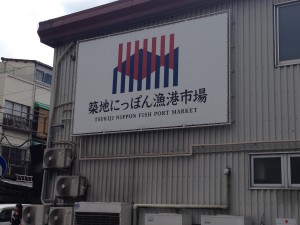
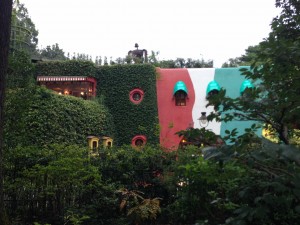
Research Internship Update
After obtaining some inconclusive data for our creatinine, Uematsu-san and I discussed with Tabata-sensei what the next step of my project should be. There were several issues with the setup for our experiment, but the major one was that the solutions weren’t sufficiently uniform for an accurate analysis. This was mostly because the creatinine didn’t readily dissolve in water, even if we only used several milligrams. Considering it was almost time for me to start working on my poster, Tabata-sensei said it would be better if we just shifted to a slightly different topic than try to resolve our current problems. He decided that I should perform experiments on glucose since it’s already been studied before. It would also help my poster if I had something to compare our creatinine results to, that way it would be easier to tell what “ideal” results should look like. It was a little disappointing to have to abandon my previous project, but fortunately since we’d essentially just be repeating our previous experiments, I finally get to have a go at doing it all myself! Well, most of it anyway. Our photolithograph is need of repairs right now, so we can’t fabricate any new metasurfaces, but I at least get to use the THz system.
Week 11: Critical Incident Analysis – In the Lab
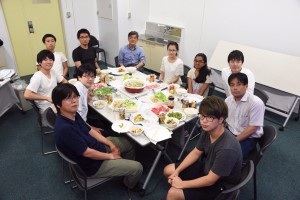
On the first week that I joined my lab, Uematsu-san told me that he and his friends were having a barbeque in Chiba that weekend. His roommate from Guatemala introduced him to a few of his friends at a picnic they went to earlier. The same group of people decided to have a barbeque on the weekend and he was looking forward to getting to know everyone some more. After he was done explaining this, he asked me if I wanted to come along. I thought it would be fun, so I said yes. I also asked him if I could invite some of the other Nakatani fellows who were in the Tokyo area. He smiled and said “Ok!” I told him I wasn’t sure if everyone could make it because some people might be busy, and he told me that it was OK if I couldn’t go or if everyone else couldn’t go. He explained that he didn’t want to pressure me into going or anything like that. I really didn’t think he was pressuring me at all, so I thought he was just being polite by saying that. This all happened on Thursday, so I told him I’d try my best to let him know by Friday at the latest about who would be coming. He then told me again that it was OK if it was too short notice for us to come, and again I reassured him that really wasn’t an issue. At that point, I started to have the slightest feeling that maybe he only invited me to be polite. Or maybe he really was worried that two days was too short notice, and he was also being polite by reassuring me that it wouldn’t be rude of me to decline. Since we did have to bring some food of our own to contribute to the barbeque, he might have thought that it would be too much trouble. I honestly had no idea at the time, but I (somewhat regrettably) went with the latter assumption. The next day, I messaged Uematsu-san to let him know that Brianna and Shweta would be able to come as well. He confirmed this and let the organizer know that three more people would come. I told him that unfortunately the rest of us couldn’t make it because of prior commitments, and he told me once again that it was OK if we couldn’t make it for any reason. I realized then that maybe he really didn’t intend on actually inviting us. In hindsight it seems much more obvious than it was then, especially because I didn’t know Uematsu-san as well at the time. But at that point, I didn’t know how to respond. I couldn’t make up an excuse after telling him we’d all be available on Saturday, especially because I had already asked Brianna and Shweta if they wanted to come. I also couldn’t directly ask him if he was just inviting us to be polite. In the end, we did all go to the barbeque, and I don’t think anyone was bothered by us being there. In fact, I ended up making some great friends who I still keep in touch with now. While I’d like to say that “all is well that ends well,” I still feel a little guilty for not realizing that Uematsu-san was just being polite earlier. I’m fairly sure he doesn’t think anything of it now and it didn’t really affect our relationship overall, but things might have gone at least a little smoother in the beginning if I had been more sensitive to his indirectness. Since this happened so early on in my internship, I kept it in mind for the rest of the summer to remind me that I shouldn’t assume that people are always being direct with me. Luckily, no other incidents like this happened following this one – as far as I can tell – and the experience did teach me how indirectness is used by Japanese people in their daily lives.
Question of the Week: Many of the daily customs in Osaka are reversed when compared to Tokyo, like standing on the right of the escalator as opposed to the left. When and why did this “rivalry” or need for contrast arise between both cities?
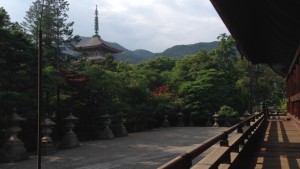
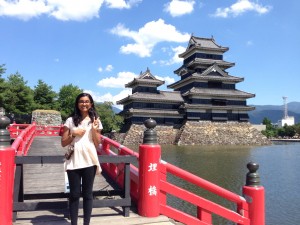
Research Project Update
Uematsu-san and I hustled to finish my experiments this week since he’s leaving for Thailand soon. He supervised me while I used the THz system, but it was pretty straightforward for the most part. The first thing we do after starting it up is do a gas purge with N2 to reduce the water vapor in the system. Since water absorbs a lot of THz radiation, we usually try to aim for at most 7% humidity. First I did three runs with the metamaterial by itself and three with just our sapphire substrate. We made solutions of 10%, 20%, and 30% glucose and did three runs with those on both sapphire and the metasurface. Handling the sample actually requires a considerable amount of dexterity. You have to be extremely careful when handling the metasurface because the substrate is so thin that the tweezers can easily slip out and scratch the surface. Another difficulty arises when we dispense the solution onto the surface. We used a micropipette to dispense 100 microliters, but it takes a steady hand to keep a consistent droplet size. After we ran the tests on all of our samples, we analyzed the data using the spectrum viewer software. The results we obtained ended up showing some interesting behavior. Although our metamaterials were designed to work in the 0.4-0.6 THz range, the glucose showed almost perfect linearity in the 1.4-1.6 THz region. For our desired region, the 30% solution deviated quite significantly from the other three solutions. We think it might have been because the solution didn’t entirely cover the metasurface during one of the trials. However, it still showed the least reflectance which is what we expected.
Week 12: Final Week at Research Lab
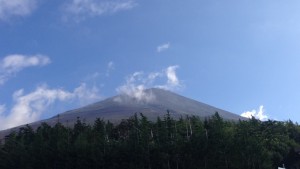
What has changed the most about your perceptions and attitudes towards Japan?
I think I’ve truly started to appreciate Japan and Japanese culture as a whole as opposed to only the things I was exposed to while in America. Japan is so much more than just the pop culture that initially enticed me into learning more about it when I was young. I really enjoyed experiencing the more traditional and historical aspects of Japanese culture, like social etiquette and daily customs. We don’t have as much access to these aspects abroad and I think it’s extremely difficult to develop a deep appreciation for a culture unless you’ve been exposed to all parts of it.
What has changed, if anything, about you personally? Are you a different in any way from when you first came to Japan?
After spending three months alone in a foreign country, the biggest change I experienced was probably in my confidence. When I used to hear about people completely uprooting their lives in their home country and moving to totally different parts of the globe, I never thought that it was something I could do too. It seemed almost reckless to abandon everything that was familiar to you and attempt to thrive in a place where you can’t even properly communicate with people yet. Although I had a lot of help along the way, in the end, living in Japan was not the hurdle I expected it to be. As long as you have the willingness to adapt and learn, living in a foreign country isn’t as difficult as it may seem.
What were the most common daily frustrations you experienced with living in Japan? What did you learn from these experiences?
In the beginning I had a really hard time with not being able to eat some of my favorite foods. In fact, I don’t think I’ve ever gone more than a few weeks without mac and cheese. While it was difficult to go without it for so long, I learned that you can often find other things that are just as good. For example, I never knew that I liked tempura so much until I started buying it from the supermarket almost every day. Brianna and I also turned into incorrigible lemon tea addicts. No matter where you are in the world, you’re likely to find something to replace those cravings for comfort food.
What will you miss most about living and working in Japan?
“Sumimasen!” I’ll definitely miss hearing that all the time. Japanese politeness is something I really appreciated even early on in my internship. Even if it seems like people are often more polite than necessary, I think it does successfully avoid any unintentional conflicts. I’m probably also just a little more sensitive than average, so being treated so kindly all the time really made me feel welcomed, whether it was in my lab or even just in a konbini.
How did this experience affect your attitudes towards academic research and your career goals?
Even though my project didn’t have the greatest results, I feel like at least this way I don’t have any unrealistic expectations about my future career. Ultimately, learning how to overcome those unexpected hurdles was a much more meaningful lesson for me, both personally and professionally. Moreover, I think this experience has made me much more inclined to participate in international research in the future. It’s a great way to gain a different approach to solving scientific problems while also becoming a more culturally aware person.
Describe your final week in the lab. What arrangements have you made to say goodbye to and thank your research group or those who have assisted you during your stay at your host institution? Did you have a going away party or other get-together before leaving your lab?
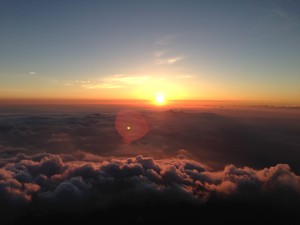
My last week in lab was mostly spent working on my poster. Uematsu-san left for Thailand on the weekend and Lili-san was busy preparing for her thesis defense. In fact, it was on the same day as my last day in lab, so most people were either busy with that or away on vacation.
My farewell party was actually last week and Uematsu-san organized for us to do shabu shabu! I was so excited to be able to finally do shabu shabu after searching for a cheap option for the whole summer. I’m really glad that I got to share such a great experience with all my lab mates, and I’ll truly miss all of the hospitality they’ve shown me. As a good-bye present, I brought Key lime flavored coconut patties for everyone from Florida, and I made cards for my mentors and Tabata-sensei. Even though it’s a small gift, I hope it expresses how grateful I am for everything they’ve done for me this summer!
How did you close out your research project and do you plan to remain in contact with your research group and/or host? Do you plan to continue this research project or research in a related area upon your return to your home university?
I’m not sure if Uematsu-san will continue to do more tests on creatinine as of now, but I definitely plan on staying in touch with my lab to see what great things they’ll work on next! I most likely won’t be able to continue this type of research at UF since it doesn’t directly relate to my existing project on peripheral nerve injury repair using hydrogel scaffolds, but I hope that it will be useful for me when I conduct neuroscience research in graduate school.
What are your plans for your final weekend in Japan?
For our last weekend in Japan, several other Nakatani fellows and I are planning on hiking up Mt. Fuji!
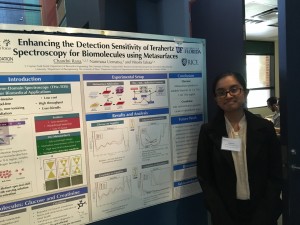
Final Research Project Abstract and Poster: Enhancing the Detection Sensitivity of Terahertz Spectroscopy for Biomolecules using Metasurfaces ![]()
Host Lab: Terahertz BIOnics, University of Tokyo
Host Professor: Hitoshi Tabata
Mentor: Narimasa Uematsu
Introduction: My project was focused on enhancing the detection sensitivity of Terahertz time-domain spectroscopy by using metasurfaces. This technique has broad applicability in the biomedical field as a means of discerning changes in solution concentrations. More specifically, we directed our methodology towards measuring creatinine, a metabolic byproduct that is widely used as a marker for renal health. Creatinine is cleared by the kidneys at a roughly constant rate every day and accumulation in either serum or urine is usually indicative of renal failure. The major shortcomings of existing practices that our technique seeks to address is cost, time, and ease of operation.
Approach: First, we fabricate the gold metasurfaces by using photolithography and sputter deposition. We initially have a sapphire substrate – which is transparent to THz radiation – and we spin coat a light-sensitive material, called a photoresist, onto its surface. In particular, we used a negative photoresist so that when the substrate is subjected to UV radiation the unexposed parts will eventually dissolve during development and the exposed parts will remain to form the photo mask. Afterwards, we sputter gold particles onto the photo mask to give the material metallic properties. The second phase of our experiment involves irradiating THz radiation onto the metasurface. We dispense 100 microliters of our test solution onto the metasurface, and then observe how the THz wave is reflected off the sample.
Results: Our creatinine results were mostly inconclusive since the region that our metamaterial was designed to operate in didn’t show a distinct shift associated with increasing concentration. The glucose did show a shift for each concentration, but the 30% solution was abnormally blue-shifted.
Discussion: The reason our creatinine data was so disordered is probably the fact that we used very low concentrations which were chosen to mimic physiologically and clinically relevant conditions. The glucose data did show a notable shift, but the 30% solution likely deviated due to an inconsistent droplet size for that concentration.
Future Research: The major next steps for our research project are to repeat the creatinine experiments at higher concentrations and to fabricate and use different metasurfaces with the THz system. Other steps we can take to improve the experimental setup are to develop a method for achieving a uniform distribution of the solution on the metasurface. One of the ways we’ve considered doing this is by spin coating the solution, but it hasn’t been confirmed if that’s feasible yet.
Conclusion: Our technique still has the potential to become a useful diagnostic tool, but at the moment there needs to be significant improvements to the experimental setup. Going forward, if we are able to see satisfying results at higher concentrations, translating that back to clinically relevant concentrations would require us to even further enhance the sensitivity of our system by looking into different metasurface patterns that could work specifically for creatinine and other similar molecules.
Return to Top
Week 13: Final Report
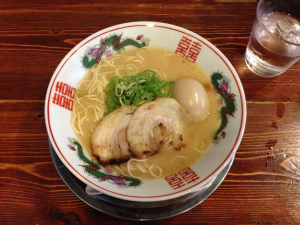
The final week was probably the busiest portion of the program. First, we got to meet the 8 Japanese Nakatani RIES fellows and together we all presented our reflections/anticipations of the program to the Nakatani foundation at Ivy Hall. Afterwards we celebrated the closing ceremony for the U.S. fellows/opening ceremony for the Japanese fellows with an incredible buffet dinner and networking opportunity. It was encouraging to see all the Japanese fellows so excited to begin their journey as “Nakatinis” (a name we coined for ourselves), but also a little bittersweet knowing we would all soon be diverging off into our own separate lives. The next day we all completed our oral proficiency interviews and swiftly made our way to the airport and finally America. It might have been disheartening to leave Japan, but being able to eat American food again did a formidable job at alleviating my misery. I don’t think I’d ever been so happy to see scrambled eggs in my life. Moreover, the re-entry program was packed with so many activities that it was difficult to find any time to brood. Some of the things we got to do included touring Rice University’s beautiful campus, seminars on resume building and applying to graduate school, and also preparing for the SCI colloquium by practicing our poster presentations. I really wish I could have better absorbed all the helpful information we were given, but jet-lag had gotten the best of me. Luckily, I felt so anxious when talking to the SCI judges that I was at least alert for my poster presentation.
When speaking to my family, I usually tend to focus on the more sentimental parts of the experience, like building some unforgettable relationships with the other Nakatani fellows and my lab mates. I personally learned so much from both my American and Japanese colleagues. The other Nakatani fellows always inspired me with their enthusiasm and open-mindedness for travel and learning. Sometimes when I just wanted to stay in my room all weekend, seeing all the amazing things they were up to really motivated me to get up and find some adventure myself. My lab mates showed me the value of both humility and dedication to your work. When I first joined my lab I felt really unprepared to do anything meaningful. Coming from a biologically-oriented background, I wasn’t even entirely sure of the fundamentals of my project. I felt so lucky work alongside such intelligent and hard-working people who still had the compassion to help someone who didn’t have any idea what she was doing.
When speaking to a professor, I would probably tend to focus on how the program has shaped my academic pursuits and approach to research. Expressing how I’ve firsthand realized the importance of international collaboration is probably something that a professor would both agree with and be interested in hearing about. Doing research requires you to look beyond both scientific and geographic boundaries. Many of the world’s greatest accomplishments weren’t completed by a single person with expertise in a very specific area. All great breakthroughs required us to work together with scientists from diverse scientific backgrounds and nationalities.
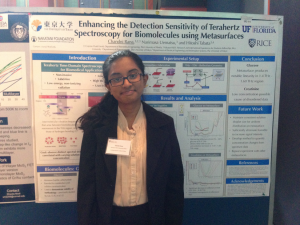
Another thing that I would mention to a professor (or really anyone) is how I learned that results are not everything. It’s great to have publication-worthy results, but not achieving that isn’t the end of the world. In fact, I frankly had some pretty unfortunate results and felt that my project wasn’t nearly as sophisticated as some of the other Nakatani fellows. That being said, I usually like to think that “there are no small roles, only small actors.” When my first project wasn’t taking off because Uematsu-san was either busy with his classes or we were unable to use the equipment as often as we needed, I started to join Lili-san on some of her experiments. In the beginning I spent a lot of time at my desk, trying to read papers and often getting distracted by something on the web. After we went into the clean room and fabricated our metamaterials for the first time, all I wanted was to keep going and learn more things. Even though my first route to doing that was inaccessible, I just found another one by helping out my other mentor. By the end of the internship, I had learned so much even though I felt like I did so little. Understanding and being able to explain your project is so much more important than achieving good results. I can’t even explain how happy my mentors were when I told them I did well at the SCI colloquium, especially since my results weren’t anything to be envied. I’ll never forget the moment when Uematsu-san told me that he was so happy to hear about my achievement that it encouraged him to try harder on his own research project! Even though Tabata-sensei and my mentors make it sound like it was my effort that made this happen, I really couldn’t have done any of it without their and Professor Stanton’s help.
When speaking to an employer the major thing I’d stress is learning that you don’t need to know everything in the beginning in order to be successful in the end. Being adaptable and willing to learn is what really matters. I remember on the first day I met Uematsu-san, I asked him how long he had been working in the lab. When he replied two months, I was taken aback. He was almost as new as I would be by the end of the program. This meant that he couldn’t answer all of the questions I had about our project because he was also learning along with me. Not to mention that his background was in applied physics and so the physiology side of our project was not very familiar to him. This worried me a little in the beginning, but I really appreciated Uematsu-san’s willingness to try and explain things to me. Even if he didn’t entirely understand it himself, he still made an effort to help me understand. Likewise, I also got to help him understand the physiology portion of our project. Being adaptable and willing to learn wasn’t just important for my research project, it was also essential to my ability to thrive in Japan. None of us really knew an extensive amount of Japanese before coming to Japan, but we were still able to manage with the little that we knew, and whatever we didn’t know we learned along the way.
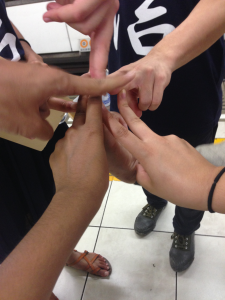
When speaking to a student at UF, I would probably say that the most important thing I learned from Nakatani RIES was to be more considerate of others. All of our Japanese hosts and Nakatani “parents” treated us with such kindness that I can’t help but feel like I should be spreading that kind of compassion myself. Thinking of others before yourself is already central to Japanese culture, but I think everyone went above and beyond to make us feel welcomed. Since I’m still in school, I feel like I’m at the point where most of my life revolves around my problems, my accomplishments, my future. Because of that, I think I often neglect thinking about what those around me are going through. Going forward I really want to embody more of the selflessness and generosity that I was fortunate enough to receive while I was Japan.
I’m excited to say that my participation in the Nakatani RIES program has actually encouraged me to pursue a minor in Asian Studies. This way, I can continue my Japanese language study at UF and also learn more about Japanese culture. Not to mention, I’m already looking for some way to go back to Japan. There are a few research internships I’m interested in doing right now, notably the UTRIP program at Tōdai. But if it doesn’t happen while I’m an undergraduate, I’m also highly interested in doing an internship at the RIKEN Brain Science Institute when I’m in graduate school.
I think myself and the other Nakatani fellows probably have the same burning question after coming back from Japan: when/ how can I go back?!
Follow-on Project
As part of my follow-on project, I am planning on presenting my program experience at the first general body meeting for the University of Florida’s chapter of the Biomedical Engineering Society (BMES). Since I’m also Director of Research and Design for UF-BMES this year, I was going to present at the R&D team’s first meeting as well. UF-BMES also does several outreach events at local middle schools and high schools in Gainesville, so hopefully I can talk about the program at those events too. My lab at UF is also very interested in hearing more about my experience in Japan, and I’ll be presenting to them in mid-September. Lastly, BMES will be having their annual meeting in Minneapolis this year in October, so if it’s possible, I think that it would be a prime location to inform other undergraduates about the Nakatani-RIES fellowship program.
I was also invited to attend the 2016 Gulf Coast Undergraduate Research Conference that was held at Rice University on October 22. I gave an oral talk on my summer research project in the Tabata Lab.
Tips for Future Participants
Pre-departure Tips: Only pack things that you really need. You’ll want as much space as possible in your luggage if you want to bring back souvenirs. Remember that you can find a lot of essential items for very cheap in Japan, like in 100 yen stores. Also, establish a good line of contact with your lab early. That way, if they send you papers or journals to better understand your research project, you will have more time to process all the information. Look on your host lab’s website to see if they have any recent lab photos. This way you can gauge how much omiyage to buy for your lab. Now is also a good time to determine whether or not you want to buy a JR pass.
Orientation Program Tips: Don’t push yourself too much. If you feel tired or jet-lagged, don’t feel bad about not going out one night. Spend time with the other fellows.
Mid-Program Meeting Tips: Practice your presentation. If possible, try practicing to your host lab or mentors. Try to think of questions people may ask. Remember to bring omiyage back for your professor(s) and lab-mates!
Working With Your Research Lab Tips: Although this probably goes without saying, remember to keep cultural differences in mind when communicating with your lab. Don’t take the “foreigner-card” for granted. While no one expects you to be fully accustomed to working in a Japanese lab, making the effort will help things go smoothly. Your lab-mates will also really appreciate it. Take part in any activities your lab organizes. Always ask questions if you don’t understand something. Take detailed notes during the experiments.
Living in your Research Host City: My host city was Tokyo, so the subway was very convenient. However, it wasn’t the cheapest. Remember that you can also take the bus or even rent a bike. Look into student discounts. I wasn’t able to get a student ID, but some of the other fellows did. The 100-yen and 300-yen stores have a lot of inexpensive things that you can buy for your dorm. Don’t try to eat in the cafeteria or from the konbini all the time. Ask your lab-mates for suggestions on restaurants.
Language Study Tips: There are plenty of apps you can download that can help you learn hiragana, katakana, and kanji. Memorizing hiragana and katakana before you take language classes is important. Also, if you don’t know the numbers already, it’s helpful to learn those beforehand since things might go a little quickly during language classes and you’ll need to know them if you want to make purchases at certain places.
What Gifts to Bring
- Gifts from your campus bookstore.
- Things from your hometown.
- The pecan flavored Keebler Sandies that Sarah recommended to us were quite popular with my lab.
What to Eat
- Try everything! Even nattō.
- My favorites were: shio ramen, tempura, and sashimi.
- Try shabu shabu.
- Eat at an izakaya.
- Indian food in Japan is also surprisingly good.
What to Buy in Japan
- There are lots of places to go to like Ito-ya and MUJI.
- Ghibli merchandise. Particularly ones that are more expensive/ unavailable in America or online.
- Save your ticket stubs, maps, and such from places that you go to. You can do what I did and make a collage out of them, if you’re into that.
What to Do in Japan
- Go to a karaoke bar
- Go to Tokyo DisneySea
- Take purikura
- Go to a cat/bunny/owl/other furry creature café
